Literature Review: Factors that Influence Drinking and Driving Habits
VerifiedAdded on 2023/04/21
|6
|1243
|182
Literature Review
AI Summary
This literature review delves into the multifaceted issue of drunk driving, exploring various factors that contribute to the likelihood of individuals engaging in this dangerous behavior. The review highlights the detrimental effects of alcohol on driving ability, emphasizing how excess consumption impairs both physical and mental stability, thereby reducing rational decision-making. Key influences discussed include peer pressure, particularly among young people, which can normalize and encourage drunk driving. Furthermore, the review underscores the importance of education regarding alcohol abuse and its consequences, suggesting that increased awareness and strict legal measures can deter individuals from drunk driving. The analysis concludes that a combination of factors, including societal influences and legal frameworks, plays a crucial role in shaping driving habits and preventing drunk driving incidents.
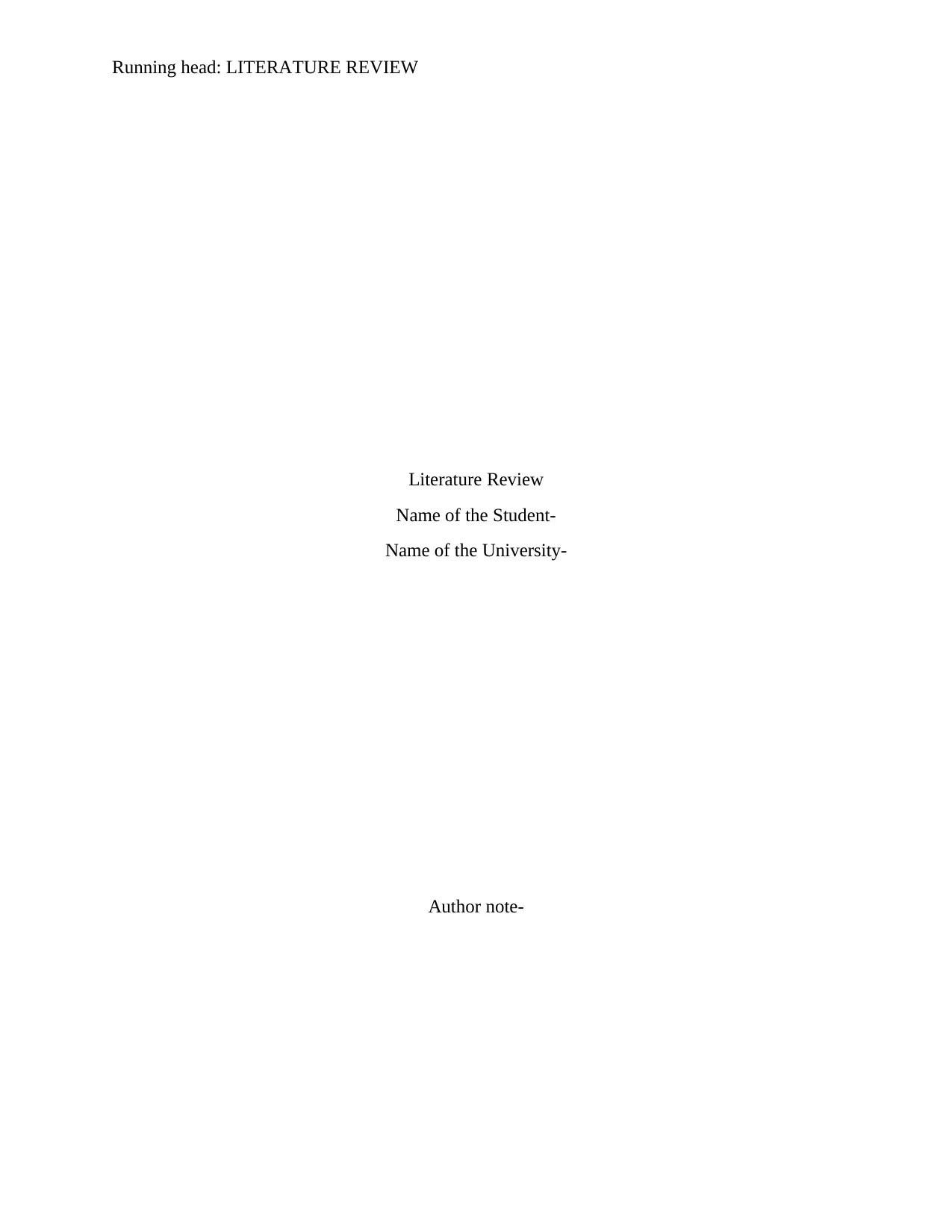
Running head: LITERATURE REVIEW
Literature Review
Name of the Student-
Name of the University-
Author note-
Literature Review
Name of the Student-
Name of the University-
Author note-
Paraphrase This Document
Need a fresh take? Get an instant paraphrase of this document with our AI Paraphraser
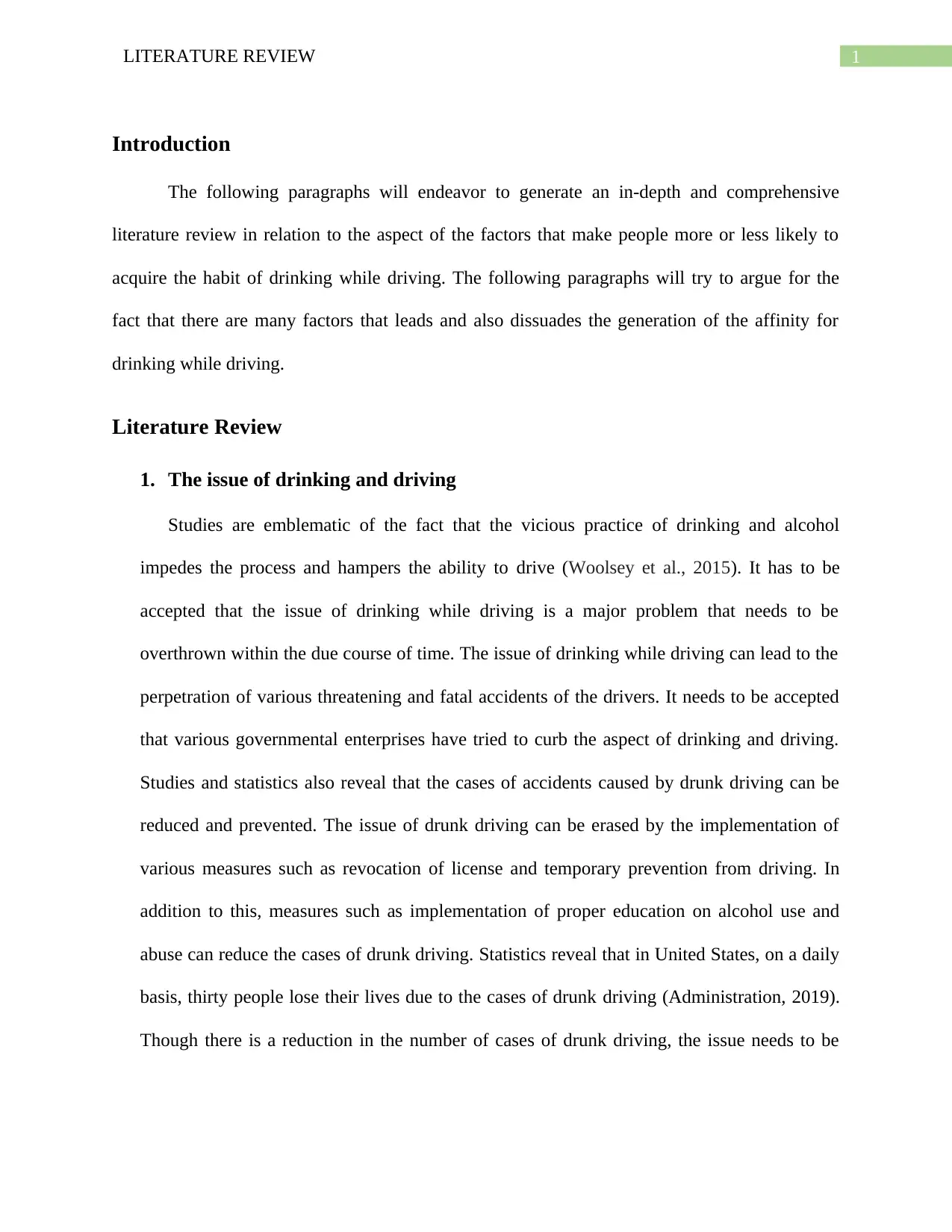
1LITERATURE REVIEW
Introduction
The following paragraphs will endeavor to generate an in-depth and comprehensive
literature review in relation to the aspect of the factors that make people more or less likely to
acquire the habit of drinking while driving. The following paragraphs will try to argue for the
fact that there are many factors that leads and also dissuades the generation of the affinity for
drinking while driving.
Literature Review
1. The issue of drinking and driving
Studies are emblematic of the fact that the vicious practice of drinking and alcohol
impedes the process and hampers the ability to drive (Woolsey et al., 2015). It has to be
accepted that the issue of drinking while driving is a major problem that needs to be
overthrown within the due course of time. The issue of drinking while driving can lead to the
perpetration of various threatening and fatal accidents of the drivers. It needs to be accepted
that various governmental enterprises have tried to curb the aspect of drinking and driving.
Studies and statistics also reveal that the cases of accidents caused by drunk driving can be
reduced and prevented. The issue of drunk driving can be erased by the implementation of
various measures such as revocation of license and temporary prevention from driving. In
addition to this, measures such as implementation of proper education on alcohol use and
abuse can reduce the cases of drunk driving. Statistics reveal that in United States, on a daily
basis, thirty people lose their lives due to the cases of drunk driving (Administration, 2019).
Though there is a reduction in the number of cases of drunk driving, the issue needs to be
Introduction
The following paragraphs will endeavor to generate an in-depth and comprehensive
literature review in relation to the aspect of the factors that make people more or less likely to
acquire the habit of drinking while driving. The following paragraphs will try to argue for the
fact that there are many factors that leads and also dissuades the generation of the affinity for
drinking while driving.
Literature Review
1. The issue of drinking and driving
Studies are emblematic of the fact that the vicious practice of drinking and alcohol
impedes the process and hampers the ability to drive (Woolsey et al., 2015). It has to be
accepted that the issue of drinking while driving is a major problem that needs to be
overthrown within the due course of time. The issue of drinking while driving can lead to the
perpetration of various threatening and fatal accidents of the drivers. It needs to be accepted
that various governmental enterprises have tried to curb the aspect of drinking and driving.
Studies and statistics also reveal that the cases of accidents caused by drunk driving can be
reduced and prevented. The issue of drunk driving can be erased by the implementation of
various measures such as revocation of license and temporary prevention from driving. In
addition to this, measures such as implementation of proper education on alcohol use and
abuse can reduce the cases of drunk driving. Statistics reveal that in United States, on a daily
basis, thirty people lose their lives due to the cases of drunk driving (Administration, 2019).
Though there is a reduction in the number of cases of drunk driving, the issue needs to be
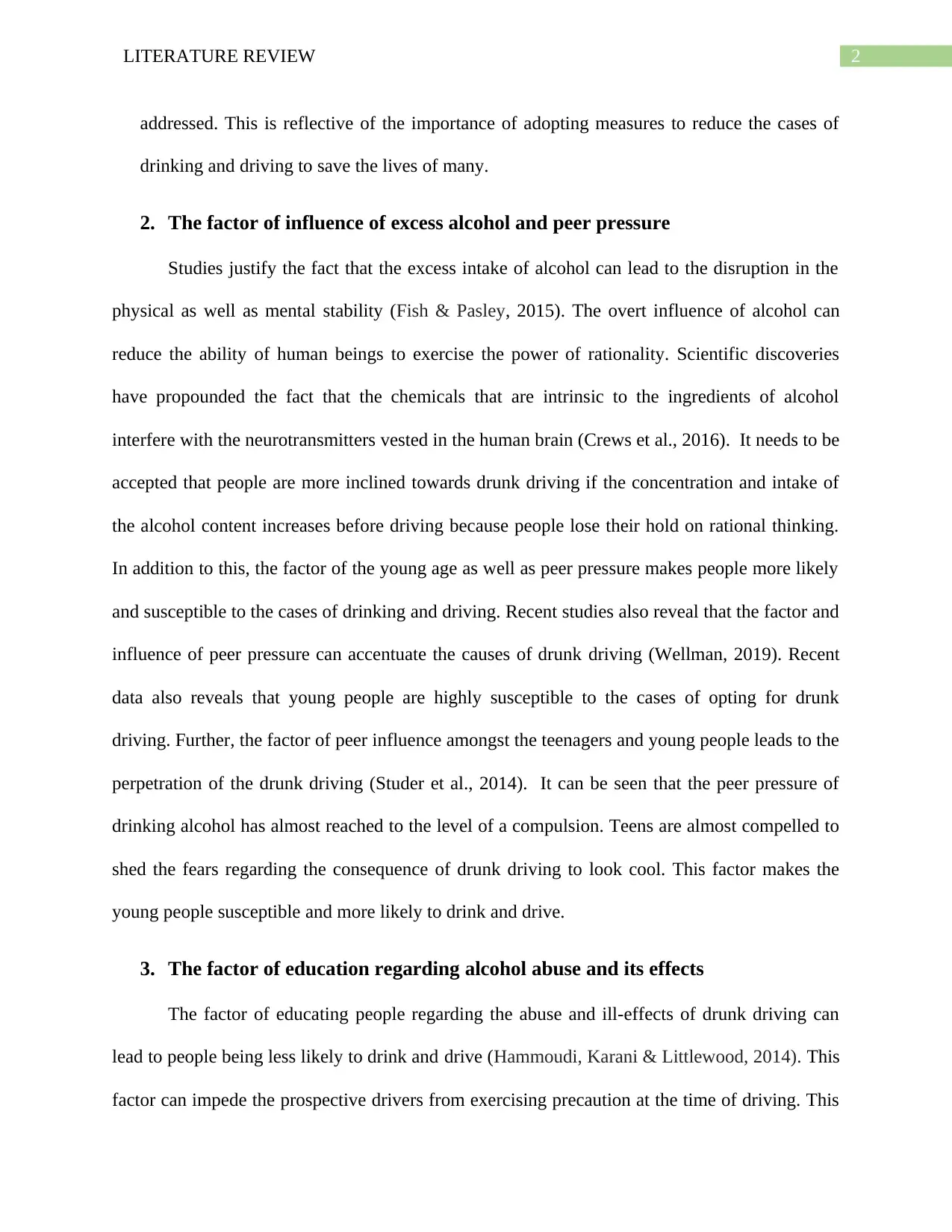
2LITERATURE REVIEW
addressed. This is reflective of the importance of adopting measures to reduce the cases of
drinking and driving to save the lives of many.
2. The factor of influence of excess alcohol and peer pressure
Studies justify the fact that the excess intake of alcohol can lead to the disruption in the
physical as well as mental stability (Fish & Pasley, 2015). The overt influence of alcohol can
reduce the ability of human beings to exercise the power of rationality. Scientific discoveries
have propounded the fact that the chemicals that are intrinsic to the ingredients of alcohol
interfere with the neurotransmitters vested in the human brain (Crews et al., 2016). It needs to be
accepted that people are more inclined towards drunk driving if the concentration and intake of
the alcohol content increases before driving because people lose their hold on rational thinking.
In addition to this, the factor of the young age as well as peer pressure makes people more likely
and susceptible to the cases of drinking and driving. Recent studies also reveal that the factor and
influence of peer pressure can accentuate the causes of drunk driving (Wellman, 2019). Recent
data also reveals that young people are highly susceptible to the cases of opting for drunk
driving. Further, the factor of peer influence amongst the teenagers and young people leads to the
perpetration of the drunk driving (Studer et al., 2014). It can be seen that the peer pressure of
drinking alcohol has almost reached to the level of a compulsion. Teens are almost compelled to
shed the fears regarding the consequence of drunk driving to look cool. This factor makes the
young people susceptible and more likely to drink and drive.
3. The factor of education regarding alcohol abuse and its effects
The factor of educating people regarding the abuse and ill-effects of drunk driving can
lead to people being less likely to drink and drive (Hammoudi, Karani & Littlewood, 2014). This
factor can impede the prospective drivers from exercising precaution at the time of driving. This
addressed. This is reflective of the importance of adopting measures to reduce the cases of
drinking and driving to save the lives of many.
2. The factor of influence of excess alcohol and peer pressure
Studies justify the fact that the excess intake of alcohol can lead to the disruption in the
physical as well as mental stability (Fish & Pasley, 2015). The overt influence of alcohol can
reduce the ability of human beings to exercise the power of rationality. Scientific discoveries
have propounded the fact that the chemicals that are intrinsic to the ingredients of alcohol
interfere with the neurotransmitters vested in the human brain (Crews et al., 2016). It needs to be
accepted that people are more inclined towards drunk driving if the concentration and intake of
the alcohol content increases before driving because people lose their hold on rational thinking.
In addition to this, the factor of the young age as well as peer pressure makes people more likely
and susceptible to the cases of drinking and driving. Recent studies also reveal that the factor and
influence of peer pressure can accentuate the causes of drunk driving (Wellman, 2019). Recent
data also reveals that young people are highly susceptible to the cases of opting for drunk
driving. Further, the factor of peer influence amongst the teenagers and young people leads to the
perpetration of the drunk driving (Studer et al., 2014). It can be seen that the peer pressure of
drinking alcohol has almost reached to the level of a compulsion. Teens are almost compelled to
shed the fears regarding the consequence of drunk driving to look cool. This factor makes the
young people susceptible and more likely to drink and drive.
3. The factor of education regarding alcohol abuse and its effects
The factor of educating people regarding the abuse and ill-effects of drunk driving can
lead to people being less likely to drink and drive (Hammoudi, Karani & Littlewood, 2014). This
factor can impede the prospective drivers from exercising precaution at the time of driving. This
⊘ This is a preview!⊘
Do you want full access?
Subscribe today to unlock all pages.

Trusted by 1+ million students worldwide
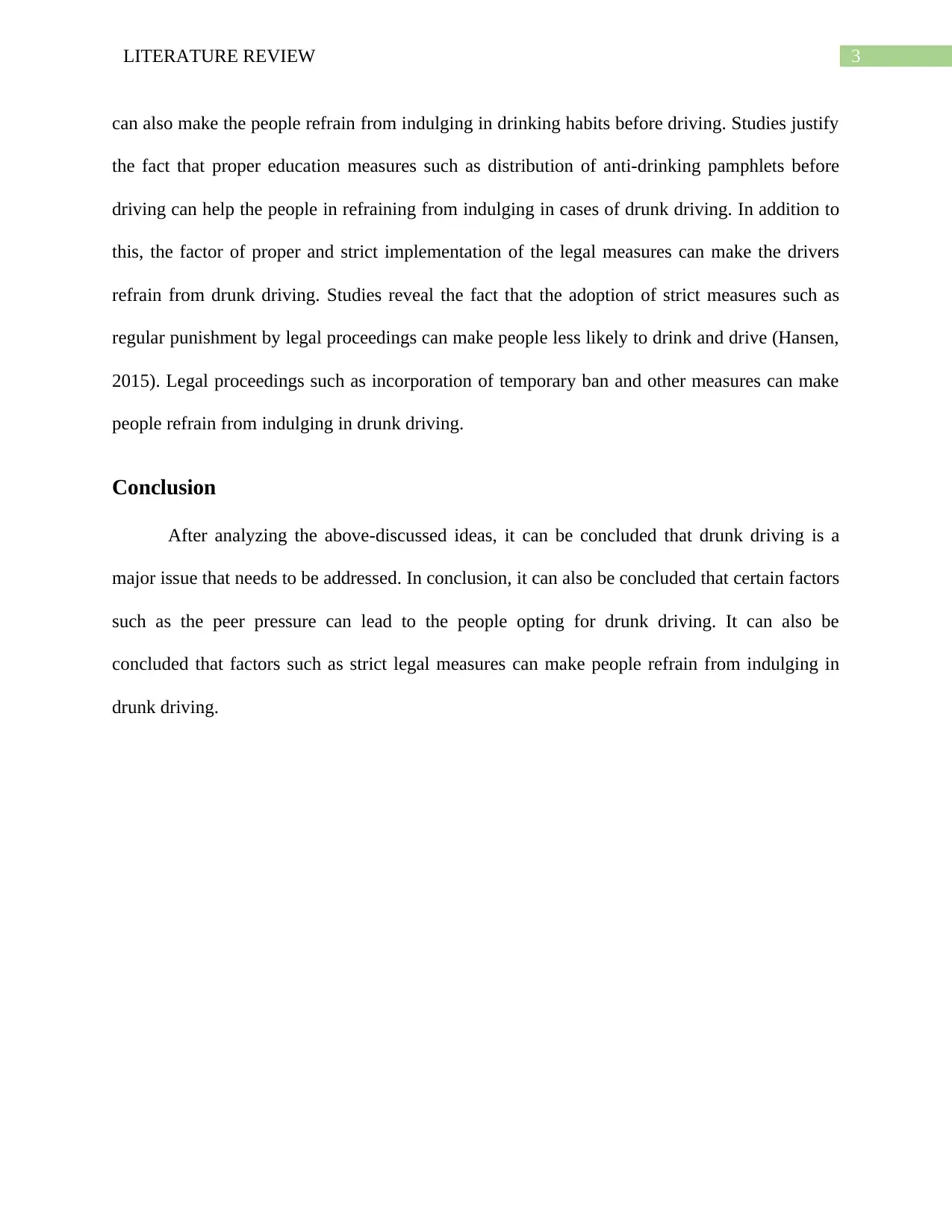
3LITERATURE REVIEW
can also make the people refrain from indulging in drinking habits before driving. Studies justify
the fact that proper education measures such as distribution of anti-drinking pamphlets before
driving can help the people in refraining from indulging in cases of drunk driving. In addition to
this, the factor of proper and strict implementation of the legal measures can make the drivers
refrain from drunk driving. Studies reveal the fact that the adoption of strict measures such as
regular punishment by legal proceedings can make people less likely to drink and drive (Hansen,
2015). Legal proceedings such as incorporation of temporary ban and other measures can make
people refrain from indulging in drunk driving.
Conclusion
After analyzing the above-discussed ideas, it can be concluded that drunk driving is a
major issue that needs to be addressed. In conclusion, it can also be concluded that certain factors
such as the peer pressure can lead to the people opting for drunk driving. It can also be
concluded that factors such as strict legal measures can make people refrain from indulging in
drunk driving.
can also make the people refrain from indulging in drinking habits before driving. Studies justify
the fact that proper education measures such as distribution of anti-drinking pamphlets before
driving can help the people in refraining from indulging in cases of drunk driving. In addition to
this, the factor of proper and strict implementation of the legal measures can make the drivers
refrain from drunk driving. Studies reveal the fact that the adoption of strict measures such as
regular punishment by legal proceedings can make people less likely to drink and drive (Hansen,
2015). Legal proceedings such as incorporation of temporary ban and other measures can make
people refrain from indulging in drunk driving.
Conclusion
After analyzing the above-discussed ideas, it can be concluded that drunk driving is a
major issue that needs to be addressed. In conclusion, it can also be concluded that certain factors
such as the peer pressure can lead to the people opting for drunk driving. It can also be
concluded that factors such as strict legal measures can make people refrain from indulging in
drunk driving.
Paraphrase This Document
Need a fresh take? Get an instant paraphrase of this document with our AI Paraphraser
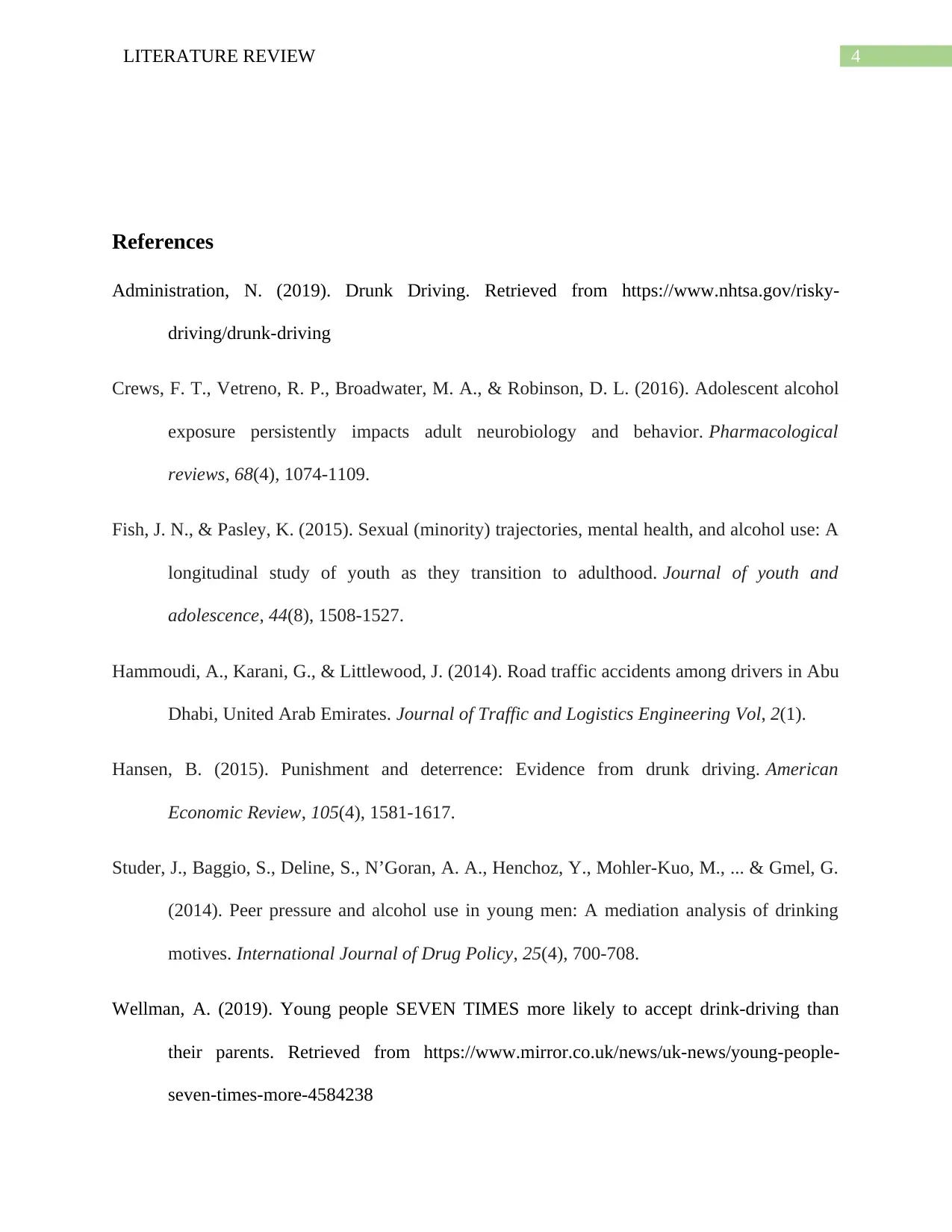
4LITERATURE REVIEW
References
Administration, N. (2019). Drunk Driving. Retrieved from https://www.nhtsa.gov/risky-
driving/drunk-driving
Crews, F. T., Vetreno, R. P., Broadwater, M. A., & Robinson, D. L. (2016). Adolescent alcohol
exposure persistently impacts adult neurobiology and behavior. Pharmacological
reviews, 68(4), 1074-1109.
Fish, J. N., & Pasley, K. (2015). Sexual (minority) trajectories, mental health, and alcohol use: A
longitudinal study of youth as they transition to adulthood. Journal of youth and
adolescence, 44(8), 1508-1527.
Hammoudi, A., Karani, G., & Littlewood, J. (2014). Road traffic accidents among drivers in Abu
Dhabi, United Arab Emirates. Journal of Traffic and Logistics Engineering Vol, 2(1).
Hansen, B. (2015). Punishment and deterrence: Evidence from drunk driving. American
Economic Review, 105(4), 1581-1617.
Studer, J., Baggio, S., Deline, S., N’Goran, A. A., Henchoz, Y., Mohler-Kuo, M., ... & Gmel, G.
(2014). Peer pressure and alcohol use in young men: A mediation analysis of drinking
motives. International Journal of Drug Policy, 25(4), 700-708.
Wellman, A. (2019). Young people SEVEN TIMES more likely to accept drink-driving than
their parents. Retrieved from https://www.mirror.co.uk/news/uk-news/young-people-
seven-times-more-4584238
References
Administration, N. (2019). Drunk Driving. Retrieved from https://www.nhtsa.gov/risky-
driving/drunk-driving
Crews, F. T., Vetreno, R. P., Broadwater, M. A., & Robinson, D. L. (2016). Adolescent alcohol
exposure persistently impacts adult neurobiology and behavior. Pharmacological
reviews, 68(4), 1074-1109.
Fish, J. N., & Pasley, K. (2015). Sexual (minority) trajectories, mental health, and alcohol use: A
longitudinal study of youth as they transition to adulthood. Journal of youth and
adolescence, 44(8), 1508-1527.
Hammoudi, A., Karani, G., & Littlewood, J. (2014). Road traffic accidents among drivers in Abu
Dhabi, United Arab Emirates. Journal of Traffic and Logistics Engineering Vol, 2(1).
Hansen, B. (2015). Punishment and deterrence: Evidence from drunk driving. American
Economic Review, 105(4), 1581-1617.
Studer, J., Baggio, S., Deline, S., N’Goran, A. A., Henchoz, Y., Mohler-Kuo, M., ... & Gmel, G.
(2014). Peer pressure and alcohol use in young men: A mediation analysis of drinking
motives. International Journal of Drug Policy, 25(4), 700-708.
Wellman, A. (2019). Young people SEVEN TIMES more likely to accept drink-driving than
their parents. Retrieved from https://www.mirror.co.uk/news/uk-news/young-people-
seven-times-more-4584238
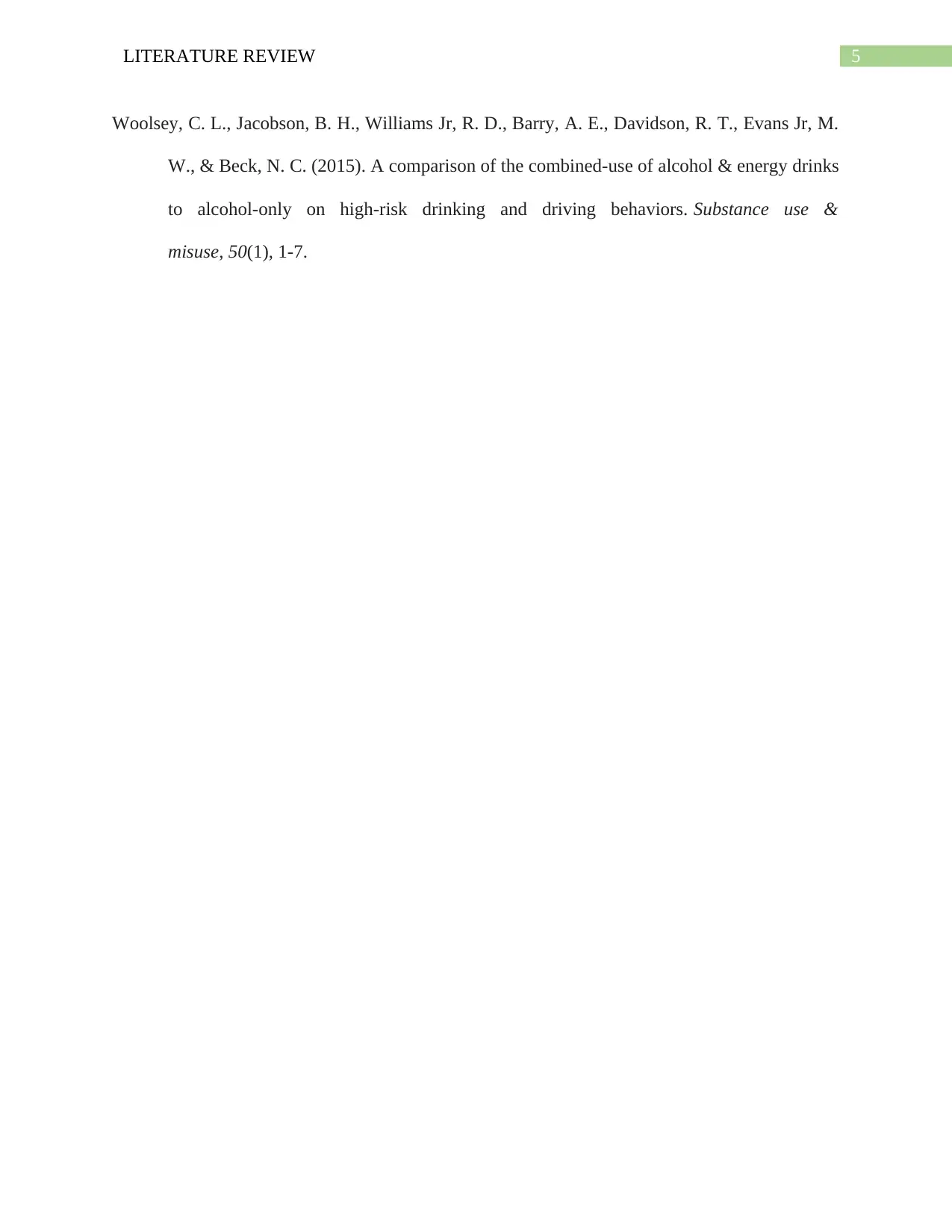
5LITERATURE REVIEW
Woolsey, C. L., Jacobson, B. H., Williams Jr, R. D., Barry, A. E., Davidson, R. T., Evans Jr, M.
W., & Beck, N. C. (2015). A comparison of the combined-use of alcohol & energy drinks
to alcohol-only on high-risk drinking and driving behaviors. Substance use &
misuse, 50(1), 1-7.
Woolsey, C. L., Jacobson, B. H., Williams Jr, R. D., Barry, A. E., Davidson, R. T., Evans Jr, M.
W., & Beck, N. C. (2015). A comparison of the combined-use of alcohol & energy drinks
to alcohol-only on high-risk drinking and driving behaviors. Substance use &
misuse, 50(1), 1-7.
⊘ This is a preview!⊘
Do you want full access?
Subscribe today to unlock all pages.

Trusted by 1+ million students worldwide
1 out of 6
Related Documents
Your All-in-One AI-Powered Toolkit for Academic Success.
+13062052269
info@desklib.com
Available 24*7 on WhatsApp / Email
![[object Object]](/_next/static/media/star-bottom.7253800d.svg)
Unlock your academic potential
Copyright © 2020–2025 A2Z Services. All Rights Reserved. Developed and managed by ZUCOL.





